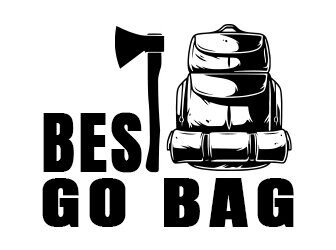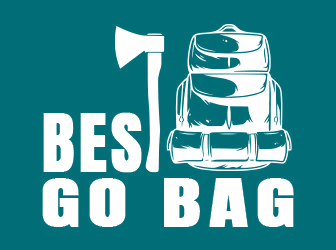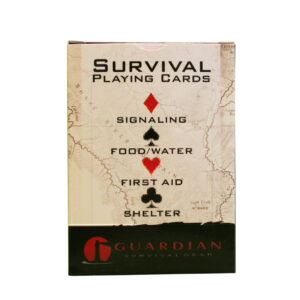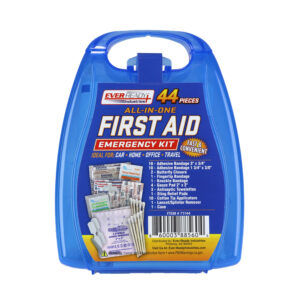What to Do in a Power Outage
The wind is blowing hard, the rain is horizontal and it’s freezing cold at 3:00 am a tree just fell onto the dining room side of the house, rain is coming in. Three trees have fallen across the only road to our side of the island, neighbors are out there cutting it up. My wife […]
Using Different Size Axes, by Steve Acker
Every year that I can make it I go on summer vacation for a week in Colorado in a remote wilderness area, camping, hiking and fishing with old buddies. It is roughly 50 miles off of the nearest paved road. The area we use is a primitive camping area and at 10,000 feet. Temperatures can […]
Unexpected Thrifty Finds?
Perhaps the most common reason people give for not preparing is money.
They say that because they live paycheck to paycheck, there’s never anything left at the end of the month for stockpiling supplies.
It’s not that they don’t believe in the concept of preparing for an uncertain future. They’re fully convinced they’d be better off with survival food, water and a bunch of other items that will be essential for dealing with a crisis.
It’s just that when they finish paying for all the stuff they absolutely have to have, everything else is a luxury.
Thrift store prepping
I completely get that, and I sympathize with the plight of those who are barely scraping by.
But I also know that occasionally some unexpected money comes in. It might not be often and it might not be a lot, but it could be enough to get a survival stockpile going.
How? By purchasing items at the lowest possible price. And by doing it over time, rather than trying to gather everything at once.
So, whether you want to get started stockpiling necessary items for an emergency or you just want to economically add to your existing stash, here are some ideas for grabbing items from a Goodwill store or other low-cost venue. Let’s call it Goodwill hunting.
An economical goldmine
Winter clothes. Coats, gloves, hats and boots can usually be found at bargain prices at Goodwill or another thrift store.
First-aid kit. This is a kit you can form by purchasing bandages, gauze and adhesive tape. You might even see a pair of crutches, a brace and a sling for sale.
Backpack. Yeah, it will be used, but so what? It will be far less expensive than a new one in a retail store. Make sure it has wide shoulder straps and a reinforced bottom.
Ponchos and other rain gear. Most of your winter clothes won’t be waterproof, so you need stuff that is. Grab an umbrella while you’re at it.
Sewing kit. Fabric, needles and thread will come in very handy when stores are not open and you have to mend clothes or a tent.
Gas can. If the grid goes down and gas stations close, a gas can filled with gasoline will be a precious commodity.
Tools. No one is going to care how shiny their tools are in a crisis. Pick up some used hammers, screwdrivers, shovels and rakes.
Blankets. Even if the inevitable disaster occurs during the warmer half of the year, nights will get cold. Wool blankets will feel like lifesavers.
Camping equipment. Look for used tents and camp stoves, which will be much cheaper at thrift stores than elsewhere.
Pots, pans and other kitchen gear. Very expensive when they’re new, these items can be found at great prices in thrift stores.
Survival items. Multi-tools, Mylar blankets and other survival gear can often be found at these types of stores.
Books/Games/Crayons. If you have to bug out and TV is a thing of the past, these items will provide boredom relief for you and the kids or grandkids.
Hunting gear. Even if you’ve never hunted before, grab some camouflage clothes, game bags and boots. You may have to hunt for your meals.
How Will You Celebrate Earth Day Today?
The folks who launched the first Earth Day in 1970 had no idea we’d still be acknowledging it today.
Some 20 million Americans made their voices heard about various issues that day. Including toxic drinking water, air pollution and the effects of pesticides.
This led President Richard Nixon to create the Environmental Protection Agency. That was followed by a number of laws. Such as the Clean Air Act, the Clean Water Act and the Endangered Species Act.
Today is the 51st annual celebration of Earth Day. The global theme this year is “Restore Our Earth.” Earth Day 2021 will include activities involving 1 billion people in 192 countries.
According to EarthDay.org, the focus will be on natural processes. As well as emerging green technologies. And innovative thinking that can restore the world’s ecosystems.
‘Largest Secular Holiday’
Earth Day is coordinated by the non-profit Earth Day Network. This organization is chaired by the first official Earth Day organizer, Denis Hayes.
He says Earth Day is now, “the largest secular holiday in the world.”
But the origin of Earth Day is generally credited to Gaylord Nelson. He’s a former Wisconsin senator, environmentalist, conservationist and activist.
He was inspired to launch what was originally an environmental teach-in. That was after he witnessed the effects of the Santa Barbara, California, oil spill in 1969.
A Handful of Campaigns
There are five Restore Our Earth campaigns. They are the Canopy Project, Food and Environment and the Great Global Cleanup. Plus Climate Literacy and Global Earth Challenge.
The Canopy Project involves reforestation efforts. They take carbon dioxide out of the atmosphere. As well as regulating temperatures and providing a habitat for animals. Plus stabilizing land from erosion and improving soil health.
The Food and Environment initiative focuses on regenerative farming. This promotes the health of degraded soils by restoring their organic carbon. The goal is to reduce erosion and water pollution, which in turn will improve the quality of produce.
The Great Global Cleanup keys in on reducing waste and plastic pollution. Climate Literacy stresses environmental education in public schools. Global Earth Challenge is a citizen scientist campaign geared toward layperson environmental projects.
Going Virtual in 2021
Most of us are staying home more these days than we used to. But that doesn’t mean we can’t celebrate Earth Day if we want to.
In other years, Earth Day has involved different events. They’ve ranged from river cleanups to the removal of invasive plants to the planting of trees.
Some of that – and other environmental activities – will go on again today. But social distancing will limit many activities.
Replacing a number of those events this year due to the pandemic will be virtual events. Including environmental lectures and films.
What Can We Do?
Here’s what Old Farmer’s Almanac editors say. “Caring for nature, plants and the land is integral to our own health. And… individual responsibility lies with each of us.”
They offer ways to do that. While minimizing contact with people outside our households. Here are five of them:
- Support our pollinators. Bring bees, butterflies, hummingbirds and other pollinating creatures to your garden by selecting the right plants. Including flowers rich in pollen and nectar.
- Clean up plastic in your neighborhood and parks. Take a walk with a trash bag and a pair of gloves. Collect plastic items people have carelessly discarded. Recycle what you can.
- Plant a tree. Hopefully there’s room in your backyard for this. One oak tree can bring in more insect and bird species than a yard full of plants. Trees also capture carbon, benefit agriculture and cool overheated places.
- Stop using pesticides and chemicals in your garden. The key to healthy plants is healthy soil. Organic soil amendments can turn your garden into a nutrient-rich environment. So your plants can thrive.
- Conserve water. Many plants don’t need nearly as much water as they are given. Study up on this. Avoid watering garden vegetables and other plants from overhead. That can produce fungal disease. Water at soil level.
Energy-Saving Tips
A big part of Earth Day is energy saving. Here are a few tips to accomplish that:
- Set the refrigerator temperature to between 36 and 42 degrees Fahrenheit. And the freezer to between -5 and +6 degrees.
- Clean the refrigerator and freezer units once or twice a year. Including removing dust from condenser coils, fins, evaporator pans and motors. The units will run more efficiently if they’re clean.
- Purchase Energy Star models of refrigerators and freezers. They’ll use less energy than older models.
- As much as possible, use small appliances. Such as toaster ovens and slow cookers rather than large ones such as ranges. Small appliances use less energy.
- Use a microwave oven rather than a range when possible. That will shorten cooking time, which saves energy.
- Clean or regularly replace air filters. Including ones used for furnaces, exhaust hoods, humidifiers and vacuums.
- When operating the garbage disposal, use cold water. This solidifies grease and moves it more easily through the disposal and pipes. Hot water requires energy to warm it.
The Most Important Tip of Them All
And finally, one of the most important ones is to use solar-powered products as much as possible. Using the free power of the sun dramatically cuts down on electrical usage.
Solar generators are a smart choice because they create an endless supply of life-saving electricity when you need it most – without gas, fumes or noise.
And I have to let you know that our new, mini solar generator, the Patriot Power Sidekick is now back in stock for a limited time.
Along with $243.90 in bonuses, the Sidekick includes a free 40W foldable solar panel, complimentary shipping and much more.
Plus, it’s all available on a convenient payment-plan.
But please know, these are only temporarily back in stock, with a limited supply available.
How To Make A Bow Drill & Start a Fire For Your Survival
Knowing how to build a bow drill from scratch and start a fire with it is a crucial skill every survivalist should know. It could spell the difference between staying warm and cozy versus freezing to death. RELATED: How to Start a Fire in The Snow Step-by-Step Guide on How to Start a Fire With […]
Your Comprehensive Camping Checklist
If camping is a regular routine for you and your family or friends, you already know what you need to pack for each trip.
But suppose you saw a list that included a few items you might not have previously thought of? Or perhaps you’re just getting into camping and would like some advice along those lines.
That’s what I’d like to discuss today. Due to restrictions involving indoor events, more people are getting out and enjoying nature these days.
There will probably be a lot of camping going on over the next six months or so. I hope this “camping checklist” helps you include all the items you might need for your next excursion. Whether it’s at a state park, a private campground or your backyard.
Don’t pack too much… or too little
A family member of mine says, “If you’ve got it, pack it.” That might be fine for a long vacation. But it’s not what you want to do for camping.
One of the most enjoyable things about camping is getting away from it all. And that means a change of pace from many of the things you see or use or wear or eat or drink everyday.
Making do with less will enhance your camping experience. And will probably lead to deeper and more meaningful conversations with loved ones. On the other hand, you don’t want to get stuck miles away from home without something you really need.
So, let’s take a look at this camping checklist. How much you pack will depend on a couple of things. One, whether you’re roughing it or going to a campground where a number of amenities are provided. Two, how long you’ll be away from home.
Either way, you won’t need everything on the list. But hopefully it will help you avoid forgetting something important.
Here it is…
- Tent, with footprints, stakes and mallet/hammer
- Ground cloth/tarp
- Sleeping bags
- Sleeping pads
- Blankets and pillows
- Headlamps, flashlights and extra batteries
- Camp table and chairs (if the site doesn’t have them)
- Lantern
- Clothesline with clips
- Toiletries
- First-aid kit
- Prescription meds
- Sunscreen and protective hats
- Insect repellant
- Lip balm
- Rain gear
- Extra clothing, including several pairs of socks and underwear
- Hiking boots
- Bandanas
- Survival knife
- Multi-tool
- Duct tape
- Paracord or rope
- Saw or ax for cutting firewood (if needed)
- Compass
- Binoculars
- Field guides for flowers and insects
- Whistle
- Walkie-talkies
- Emergency radio
- Backpack
- Disinfectant wipes
Cooking without electrical power
I purposely left off food and food-related items from the list above. We’ll get to them in a moment.
In most camping situations, there are few if any eating establishments nearby. That’s OK. Food tastes better while you’re camping if you cook it yourself. And no matter what else you do or don’t do while camping, you have to eat.
The issue then becomes, how will you cook your food without electricity? Here are three ways to do that.
- Grills and open-fire cooking. Grills use gas or charcoal. They have an advantage over open-fire cooking because their lids trap more heat. Open-fire cooking is a simple outdoor solution. Set a barbeque grill plate over an open fire and cook.
- Solar oven cooking. The trapped heat is used to cook food. You can bake, boil, steam, stew and even dehydrate food. This is a safe option without flames. No fossil fuels are required and no air pollution is produced.
- Portable gas stoves. The two best options are butane and propane. Butane stoves are portable and can generate enough heat to do most cooking. Propane is a highly dependable fuel at freezing temperatures and high altitudes.
Don’t forget the food
Now for those promised food-related items:
- Perishable food packed in a cooler or ice chest
- Non-perishable food for snacking
- Plenty of bottled water and other beverages
- Personal water purifier
- Fire starters
- Cooking, serving and eating utensils
- Cooking pots, pans, plates and cups
- Tongs and skewers
- Oven mitts
- Cutting board
- Tablecloth with clips or tape
- Canteen/thermos
- Coffee pot
- Can opener
- Heavy duty aluminum foil
- Dishwashing liquid and sponges
- Paper towels and napkins
- Zip-top bags
- Trash and recycle bags
Camping trips may be the most enjoyable times of your year. Getting away from it all and getting back to nature at the same time can do wonders for your mental and emotional state during a trying time.
Just don’t forget to pack anything before you leave.
Training Vs. Gear, What You Know Matters [PODCAST]
The Survival and Basic Badass Podcast Episode: Training Vs. Gear, What You Know Matters You Might Also Like: Camping Gears | Camp Like A Genius With These 25 Additions 377 Survival Hacks And Skills You Should Know Are Switchblades Legal? Knife Laws By State Calling all preppers, craftsmen, bushmasters, outdoorsmen, and all-around skilled people, Survival […]
What Is A Ferro Rod And How To Use It
Any experienced survivalist knows that a Ferro rod is the survival gear you never step into the outdoors without. Here is everything you need to know about this invincible survival tool. RELATED: Do You Have A Ferro Rod In Your Survival Kit? Here Are 9 Reasons You Should! The A to Z of the Ferro Rod […]
How To Make A Paracord Belt To Stay Prepared [Video]
Make yourself a quick deploy paracord belt with this step-by-step video tutorial. This isn’t your basic belt, but it’s a survival belt that could save your life! RELATED: How To Make Paracord Survival Bracelets | DIY Survival Prepping DIY Paracord Belt Every Prepper and Survivalist Needs Why All Survivalists Must Have Their Own Paracord […]
Why You Need a Portable Power Bank
When I was a kid, I would frequently tell my parents I “needed” one thing or another.
Maybe it was something small like a pack of Topps baseball cards. Or something bigger like a new basketball. Perhaps it was a single G.I. Joe action toy. Or a whole set of plastic Army men figures.
Regardless, I would try to convince them that this was an essential thing for me to possess. My parents would then explain to me the difference between wanting something and needing something.
I’m reminded of this because when cellphones first became widely available, I saw them as a “want” rather than a “need.” Now I realize I need one. And if a cellphone is a need, so too is a portable way to keep it charged.
Today I want to tell you why I believe portable power banks are a necessity, not a luxury.
Charge your cellphone
Perhaps the single best reason for carrying a power bank with you wherever you go is to charge your cellphone. Cellphones are great, but their batteries… not so much.
Now, some people are on their cellphones all day long. Others only use them occasionally. Cellphones are used for many different purposes.
Like calling, texting and photo taking and sharing. Plus news gathering and social media interaction. As well as gaining directions and enjoying entertainment. It’s not surprising their batteries wear down quickly.
There’s not always an outlet available for charging your phone when you’re out and about. And even when there is, such as at an airport or coffee shop, juice jacking can be a concern.
You don’t want a dead phone when you really need it. Like when you’re lost or in a life-threatening situation. A portable power bank can keep that from happening.
Charge other devices
You may use your cellphone more than any other electronic device. Then again, you might use a laptop, tablet, iPod, GPS or other device more frequently.
A portable power bank will come in handy for charging those devices as well. Again, especially if you’re using them away from home.
Or maybe you find that a couple of your devices need charging at the same time. Portable power banks can handle that chore with multiple USB ports.
They are also very convenient to carry around. You can fit most of them in a shirt or pants pocket. Or a backpack pocket. So it will always be with you when you need it.
Traveling, hiking or camping
Portable power banks are especially helpful when you are in transit. Or when you’re camping, hiking or fishing.
Seldom are there outlets handy for charging a cellphone or other device in these circumstances.
But with a fully-charged power bank – or better yet, several power banks – you don’t have to worry about your devices dying.
Portable power banks will supply your devices with exactly what they need during your temporary time away from electrical outlets.
Rough and tough
Another great reason to carry a portable power bank is because they are rugged. They can withstand a fall or a bump.
When making a portable power bank choice, make sure it’s also water-resistant. You don’t know what the weather will be like when you need to use it.
And if you were to drop it into a puddle or even a body of water, you want to make sure it will still work properly.
Many people keep a fully-charged portable power bank in the glove compartment of their vehicle. Even if it bounces around while you’re on rough terrain, it will work perfectly.
Providing convenience
Now, this does not exactly qualify as a life-threatening problem. But sometimes you just don’t feel like getting up.
Let’s say you’re in your favorite chair and notice that your cellphone, laptop or other device is running low on batteries.
Or maybe you’re lying in bed listening to an audiobook or watching a movie on your tablet and notice the same thing.
Yeah, you could get up, plug the device in and try to get comfortable elsewhere. But why not just use your portable power bank to keep the device running until you have time to charge it in an outlet again?
Aiding others
When we think of self-sufficiency, we think about how we can take care of ourselves. This makes perfect sense. After all, it’s “self” sufficiency.
But another reason some of us wish to be self-reliant is because we want to be in a position to help others who may not be.
Like you, I need to take care of myself and my family first. But if I have more than enough – whether it’s food, water or power – I can come to the aid of someone who doesn’t.
Someday you might find yourself in a position to help a stranger who desperately needs to charge his phone or other device. If you have several portable power banks with you at the time, you could make a new friend for life.
Help from above
Now, what if your portable power bank runs out of juice and there is no outlet available? You’re sunk, right?
Not if your portable power bank can be charged with the free power of the sun. If it has a built-in solar panel, you’re in business.
Some solar-powered portable power banks even feature a built-in flashlight to help you see in the dark.
Which is especially helpful if your phone needs recharging and can’t provide the light it normally does.
Not All Power Banks Are Created Equal
I hope I’ve convinced you that a portable power bank is more than a luxury. You may find that you “need” it much more than you “want” it. I believe your best option is to have backup power that recharges from the free power of the sun. And my top recommendation is the Patriot Power Cell.
The Patriot Power Cell is small but mighty. It’s perfect for those of us on-the-go, anytime your cellphone needs a recharge. You can take it to the store or anywhere else… it’ll fit in your purse, your backpack, even your back pocket. Heck, you can even keep it on the dash so it can recharge as you drive.







